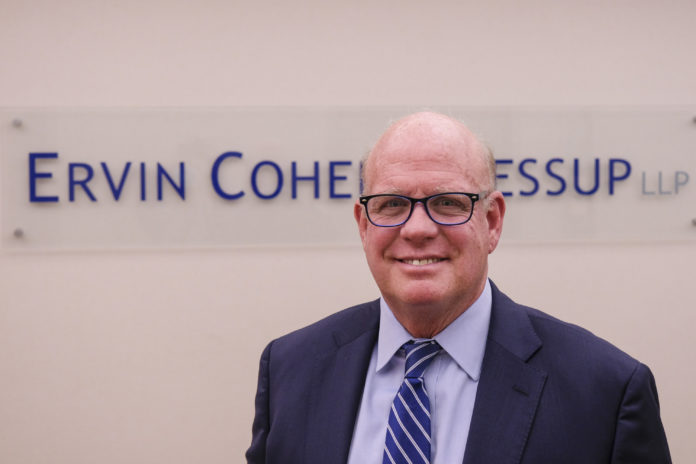For most, though, that impact never really came.
Barry MacNaughton, a litigator who focuses his practice on real estate, construction law and contractual disputes, among other areas, said the early days of the Covid-19 outbreak were rife with panic and doubt, as many would-be buyers tried to back out of deals.
As co-manager of Beverly Hills-based law firm Ervin Cohen & Jessup, MacNaughton had to consider a similarly guarded position.
“At the outset of the pandemic, we created a contingency plan in which expense cuts and other steps were outlined in phases depending on revenues,” MacNaughton said.
The firm, founded in 1953, initially addressed the pandemic with a small decrease in partner draws and a freeze on staff salaries, MacNaughton said. But by June or July, he said it had become apparent to both the firm and its clients that the sky had not fallen.
“We expected revenues to go down. We were mindful of the housing crisis that went on back in 2008 through 2010. We were thinking about that. But that didn’t happen for us at all,” MacNaughton said. “The market for commercial property has remained extremely strong.”
As a result, the firm restored partner draws last fall and was able to avoid salary cuts to nonpartner attorneys and staff.
Ervin Cohen & Jessup ended the year with a 5% drop in revenue, but that’s compared to its record-breaking year of 2019.
“Our revenue and profits for 2020 were significantly higher than in 2018, which was our best year prior to 2019,” MacNaughton said.
‘Exceeding expectations’
‘Exceeding expectations’
“After the first of the year, from a deal flow perspective, we’re having trouble keeping up with the demand,” he said. “We ended up exceeding pre-Covid expectations for calendar year 2020.”
Amir Torkamani, a real estate attorney and partner at Century City-based Sauer & Wagner, said the pace at his practice has been similarly frenzied, particularly in the residential real estate market.
“At first, there was a sort of panic mode. Supply dropped significantly because no one was willing to put their homes on the market,” Torkamani said. “Since then, there’s been a huge uptick in demand, primarily for single-family homes, and there’s still an inventory problem.”
Since the start of 2021, deals closed by Torkamani’s practice group include a 3,900-square-foot home in Encino with six bedrooms and six bathrooms, priced at $2.9 million, and a 1,704-square-foot home on Military Avenue in West Los Angeles with three bedrooms and 1.75 bathrooms for $1.73 million.
On the commercial side, MacNaughton’s Covid-era practice has dealt with multiple purchase and sale deal agreements. The firm’s also been dealing with more construction litigation, ranging from payment claims from contractors who haven’t been compensated to the classic construction defect case.
Last year, MacNaughton said he was involved in 10 construction defect cases, double his typical volume. These disputes arise when a construction project suffers a contract breach.
‘Everybody’s building’
‘Everybody’s building’
During the pandemic, MacNaughton’s real estate group led the refinancing of a 60,000-square-foot center on Yorba Linda Boulevard and an 89,000-square-foot building at 898 N. Pacific Coast Highway in El Segundo. His group also led the purchase of Summit IV, a 297,000-square-foot office complex in Aliso Viejo.
The experience hasn’t been as smooth from the litigator’s perspective, MacNaughton said, as courts remain in chaos, and many cases are frozen. The delays have tended to give one side or the other — usually the defense — a bit more leverage in negotiations, leading to fewer cases being settled.
MacNaughton said trial lawyers are doing their best to move their cases forward and capitalize on unconventional solutions in the meantime.
“I’ve actually had an arbitration that took place in a hotel ballroom in Thousand Oaks,” MacNaughton said. “The depositions are continuing. Doing them over Zoom has been OK, in most cases, though not great.”
The remote work that has defined employment in the time of Covid will continue to exist in some capacity once the pandemic is in the rear-view, Torkamani said, and he expects the elevated demand will be the “new normal” for the foreseeable future.
The boon for L.A.-adjacent areas like Long Beach will be especially resonant, he said, as potential buyers are less daunted by what would have been an hour-plus commute in the pre-pandemic days.
“The concept of working at home has become much more acceptable, and as we get out of the pandemic, it seems like it will be here to stay,” Torkamani said.
If he owned commercial real estate though, Torkamani said he might be a bit more worried.
Back to the office?
Back to the office?
MacNaughton speculated that the desire for a resurgent office market may be the subject of a generational divide; older attorneys are more comfortable with what’s familiar, while younger attorneys are more eager to venture into the unknown. In the meantime, he said, the firm’s looking to redesign its office space to achieve a happy medium.
“We’re redoing our office space next year to unclutter all the space, so people feel comfortable once they come back,” MacNaughton said. “We’re renovating with pandemics in mind.”
Pappas’ guess is many firms that suddenly find their offices having an overabundance of space would consider alternatives like hoteling.
“Firms have been bleeding money to give partners these incredible palatial offices,” Pappas said. “I think that may change.”
“There’s so many views across the board,” he added. “Some think when everything opens back up, people will forget about this, and we’ll be going back to the world of 2019. Then there are those at the other end of the extreme who think metropolitan offices will be dinosaurs.”
In the meantime, firms are buckling down and keeping their eyes on the horizon.
“You see right there, that’s one of the changes in our practice,” Pappas said.

